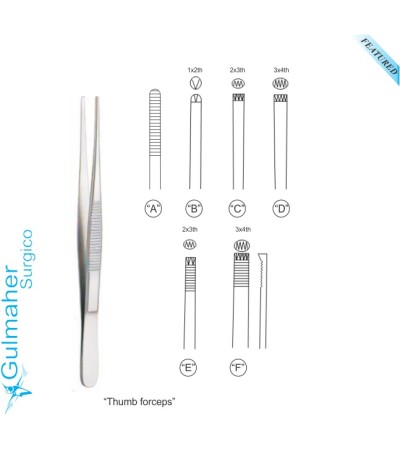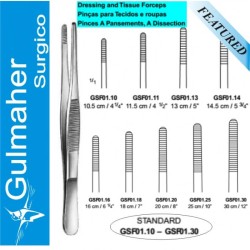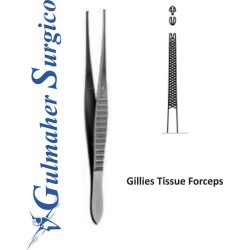
- Stock: In Stock
- Article #: 1507-14
- SKU: 1507-14
Available Options
Description of Thumb dressing and tissue forceps with Teeth
Thumb forceps are commonly held between the thumb and two or three fingers of one hand, with the top end resting on the first dorsal interosseous muscle at the base of the thumb and index finger. Spring tension at one end holds the grasping ends apart until pressure is applied. This allows one to quickly and easily grasp small objects or tissue to move and release it or to grasp and hold tissue with easily variable pressure. Thumb forceps are used to hold the tissue in place when applying sutures, to gently move tissues out of the way during exploratory surgery, and to move dressings or draping without using the hands or fingers.
Thumb forceps can have smooth tips, cross-hatched tips, or serrated tips (often called 'mouse's teeth'). Common arrangements of teeth are 1×2 (two teeth on one side meshing with a single tooth on the other), 7×7, and 9×9. Serrated forceps are used on tissue; counter-intuitively, teeth will damage tissue less than a smooth surface because one can grasp with less overall pressure. Smooth or cross-hatched forceps are used to move dressings, remove sutures, and similar tasks.
Material: 410 Stainless Steel.
Finish: Satin.
- Sterilization: Surgical instruments may be steam autoclaved at a temperature of 121°C (250°F) for 30 minutes or flash autoclaved at a temperature of 127° to 132°C (260° to 270°F) for 10 minutes.
- Recommended Sterilization Parameters: PRE-VAC Unwrapped Goods Cycle 5 minutes at 132° C/270° F. Dry Time: none recommended.
Wrapped Goods Cycle 5 minutes @ 132° C/270° F Dry Time: 5‐20 minutes*
- Recommended Gravity. Unwrapped Goods Cycle 10 minutes @ 132° C/270° F Dry time: none recommended. Wrapped Goods Cycle 30 Minutes @ 132° C/270° F Dry Time: per facility recommendation. Wrapped Goods Cycle 60 Minutes @ 132° C/270° F Dry Time: per facility recommendation. *Depending on Hospital Protocol* Warning: Flash sterilization is not the recommended sterilization method. All surgical instruments and parts should be steam autoclaved when time permits. However, flash sterilization may be used when there is an immediate need for an instrument, injector, or accessory and there is no other alternative.
- Aeration: As required to return to room temperature or to start the next cycle.
- Contraindication: Hospital policy and procedure(s) take precedence over this protocol. Failure to use approved cleaning and sterilization procedures may void the warranty.
- Cleaning Instructions: Cleaning: All instruments must be cleaned to remove contaminated substances before sterilization. After each use, perform an initial cleaning within the sterile field by wiping the tool or instrument free of blood and body fluids. Then clean the instrument thoroughly with a mild soapy solution. Do not use alkaline-based cleaners. Complete preparation for sterilization by hospital procedure using an approved cleaning agent. Do not run any type of abrasive materials or steel brushes through the lumen of the tool. The abrasive material can score the inside of the tool, rendering them inefficient. After flushing, the instrument needs to be well-rinsed with warm to hot water. Visually inspect each instrument to ensure all fatty deposits are removed. All instruments should be cleaned and rinsed with mild, non-abrasive, grease-removing cleaners before they are sterilized. Gulmaher Instruments recommends that during the cleaning and rinsing procedures, all instruments should be inspected. Ultrasonic cleaning after manual cleaning is recommended.
Refund / Return Goods Policy
- Item must be in unused condition and the original packaging Or unopened. Sterilized, taped, modified, or abused items cannot be returned or refunded for credit.
- The customer is responsible for returning the item(s) to Gulmaher. Gumaher will issue merchandise return labels if the return is a result of Gulmaher's mishandling (shipping error, etc.).


